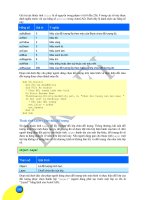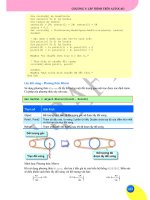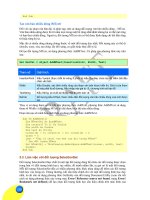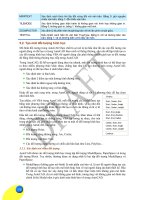Phân tích định tính sử dụng NVivo phương pháp 5 yếu tố QDA
Bạn đang xem bản rút gọn của tài liệu. Xem và tải ngay bản đầy đủ của tài liệu tại đây (13.41 MB, 235 trang )
QUALITATIVE ANALYSIS USING NVivo
Software is cut and dried—every button you press has a predictable effect—but qualitative analysis
is open ended and unfolds in unpredictable ways. This contradiction is best resolved by separating
analytic strategies—what you plan to do—from software tactics—how you plan to do it. Expert NVivo
users have unconsciously learned to do this. The Five-Level QDA® method unpacks the process so
that you can learn it consciously and efficiently.
The first part of the book explains how the contradiction between analytic strategies and software tactics is reconciled by “translating” between them. The second part provides both an in-depth
description of how NVivo works and comprehensive instruction in the five steps of “translation.”
These steps are illustrated with examples from a variety of research projects. The third part contains
real-world qualitative research projects from a variety of disciplines, methodologies, and kinds of
qualitative analysis, all illustrated in NVivo using the Five-Level QDA method. The book is accompanied by three sets of video demonstrations on the companion website.
The book and accompanying videos illustrate the Windows version of NVivo. As there are
some differences in screen and interface design between the Mac and Windows versions please
watch the video ‘The NVivo Mac Interface’ in the Component Orientation series of videos (available on the companion website).
The Five-Level QDA method is based on the authors’ combined 40 years of experience teaching
NVivo and other software packages used as platforms for conducting qualitative analysis. After many
years observing their students’ challenges, they developed the Five-Level QDA method to describe the
process that long-time NVivo experts unconsciously adopt. The Five-Level QDA method is independent of software program or methodology, and the principles apply to any type of qualitative project.
Nicholas H. Woolf has worked as an independent qualitative research consultant, coach, and
trainer since 1998. He has conducted or consulted on numerous research studies, from single-site
to multinational studies in various fields in the behavioral sciences using a wide range of methodologies, from highly structured content analyses, to evaluations, grounded theory-style projects,
and interpretive phenomenology. As a trainer Nick specializes in teaching qualitative analysis using
ATLAS.ti. He has conducted 285 workshops at over 100 universities and other institutions, primarily in the USA and Canada, for more than 3,000 PhD students, professors, and research and
evaluation consultants. In 2013 Nick introduced Five-Level QDA in his keynote address at the first
ATLAS.ti user’s conference in Berlin (Woolf, 2014).
Christina Silver has worked at the CAQDAS Networking Project at the University of Surrey,
UK, since 1998. She is responsible for capacity-building activities and has designed and led training
in all the major qualitative software programs, including ATLAS.ti, Dedoose, MAXQDA, NVivo,
Transana, QDA Miner, Qualrus, and Quirkos. Christina also works as an independent researcher,
consultant, and trainer, supporting researchers to plan and implement computer-assisted analysis
and contributing to doctoral research programs in several UK universities.
Developing Qualitative Inquiry
Series Editor: Janice Morse
University of Utah
Books in the Developing Qualitative Inquiry series, written by leaders in qualitative inquiry, address
important topics in qualitative methods. Targeted to a broad multi-disciplinary readership, the
books are intended for mid-level to advanced researchers and advanced students. The series forwards the field of qualitative inquiry by describing new methods or developing particular aspects
of established methods.
Other Volumes in This Series Include
Mixed Methods in Ethnographic Research
Historical Perspectives
Pertti J. Pelto
Engaging in Narrative Inquiries with Children and Youth
Jean Clandinin,Vera Caine, Sean Lessard, Janice Huber
Interpretive Description
Qualitative Research for Applied Practice, 2nd Edition
Sally Thorne
Qualitative Ethics in Practice
Martin Tolich
For a full list of titles in this series, please visit www.routledge.com
QUALITATIVE ANALYSIS
USING NVivo
The Five-Level QDA® Method
Nicholas H. Woolf and Christina Silver
First published 2018
by Routledge
711 Third Avenue, New York, NY 10017
and by Routledge
2 Park Square, Milton Park, Abingdon, Oxon, OX14 4RN
Routledge is an imprint of the Taylor & Francis Group, an informa business
© 2018 Taylor & Francis
The right of Nicholas H. Woolf and Christina Silver to be identified as authors of
this work has been asserted by them in accordance with sections 77 and 78 of the
Copyright, Designs and Patents Act 1988.
All rights reserved. No part of this book may be reprinted or reproduced or utilised
in any form or by any electronic, mechanical, or other means, now known or
hereafter invented, including photocopying and recording, or in any information
storage or retrieval system, without permission in writing from the publishers.
Trademark notice: Product or corporate names may be trademarks or registered
trademarks, and are used only for identification and explanation without intent to
infringe.
Five-Level QDA is a trademark owned by Christina Teal and Nicholas H. Woolf,
registered as European Community Trademark Registration Number 015596976,
and United States Trademark Serial Number 87080134.
Library of Congress Cataloging-in-Publication Data
A catalog record for this book has been requested
ISBN: 978-1-138-74366-3 (hbk)
ISBN: 978-1-138-74367-0 (pbk)
ISBN: 978-1-315-18166-0 (ebk)
Typeset in Bembo
by Apex CoVantage, LLC
Visit the companion website: www.routledgetextbooks.com/textbooks/5LQDA
Dedicated to Ben Woolf,
who fearlessly overcame
seemingly insurmountable obstacles
with grace and humor.
1980 –2015
CONTENTS
List of Figures
List of Tables
List of Boxes
Acknowledgments
Case Contributors
xiv
xvi
xviii
xix
xxi
Orientation
1
PART I
The Principles of the Five-Level QDA Method
11
1
Strategies and Tactics
13
2
Developing Objectives and Analytic Plans (Levels 1 and 2)
26
3
Translating Analytic Tasks Into Software Tools (Levels 3, 4, and 5)
44
PART II
The Five-Level QDA Method in Practice
59
4
Orientation to NVivo
61
5
The Architecture of NVivo
66
6
Mastering the Process of Translation
111
viii
Contents
PART III
Case Illustrations
153
7
Orientation to Case Illustrations
155
8
Case Illustration — An Exploratory Literature Review: Exploring
the Literature on Interfaith Dialogue
Elizabeth M. Pope
164
9
Case Illustration — A Program Evaluation: Violence Prevention Initiative
Kristi Jackson
Appendices
Appendix 1: Three Levels of Detail of Analytic Tasks
Appendix 2: Five Analytic Activities
Appendix 3: Examples of Units in Analytic Tasks
Appendix 4: Identifying the Units of Analytic Tasks
Appendix 5: Identifying the Purpose of Analytic Tasks
Index
178
195
197
198
201
202
205
208
EXTENDED CONTENTS
List of Figures
List of Tables
List of Boxes
Acknowledgments
Case Contributors
xiv
xvi
xviii
xix
xxi
Orientation
1
PART I
The Principles of the Five-Level QDA Method
11
1
13
Strategies and Tactics
The Contradictions Between Strategies and Tactics 13
Different Ways to Reconcile Contradictions 18
One-Level QDA 19
Three-Level QDA 19
Five-Level QDA 22
References 24
2
Developing Objectives and Analytic Plans (Levels 1 and 2)
Level 1: Objectives 28
Clear Objectives 28
Adopting a Methodology 29
An Everyday Illustration 33
Level 2: Analytic Plan 35
The Conceptual Framework 37
Analytic Tasks 38
Knowing What You Plan to Do Next 41
References 42
26
x
3
Extended Contents
Translating Analytic Tasks Into Software Tools (Levels 3, 4, and 5)
44
Level 3: Translation 44
The Framing of Analytic Tasks 45
The Framing of Software Features 46
The Process of Translation 48
Level 4: Selected-Tools 50
Level 5: Constructed-Tools 53
The Sequence of Tasks 54
References 56
PART II
The Five-Level QDA Method in Practice
59
4
61
Orientation to NVivo
The Different Versions and Editions of NVivo 61
Working in Teams 62
Delegation 62
Leadership Style 63
Constraints 63
Frequency of Integration When Working With the Single-User Versions of NVivo 64
Using NVivo for Teams 65
5
The Architecture of NVivo
The Different Versions of NVivo 66
Component Orientation Videos 66
The Organization of the Program 66
Components 67
Components Are Not the Same as Project Items 67
Actions 67
Tools 68
The NVivo Interface 68
The NVivo Project 69
Importing Data to an NVIVO-PROJECT 69
Backing Up an NVIVO-PROJECT 72
One NVIVO-PROJECT per Research Project 72
Providing Data 72
Sources 73
Folders 76
Cases 78
Attribute-Values 79
Conceptualizing Data 81
References 83
Nodes 84
Coded-References 91
Query-Results 94
Sets & Search-Folders 96
66
Extended Contents
xi
Writing 99
Annotations 99
Memos 100
Visualizing 101
Maps 101
Charts 103
The NVIVO-PROJECT as a Whole 105
Interrogating 105
Outputting 106
Keeping Up to Date 107
Backing Up and Moving Projects 107
Working in Teams Using NVivo 108
Everyone on the Same Cycle 108
What Happens When You Merge 109
Principles of the Foolproof Method 109
Procedures of the Foolproof Method 110
Inter-rater Reliability 110
References 110
6
Mastering the Process of Translation
Translation as a Heuristic Process 112
Writing Analytic Tasks 113
The Analytic Planning Worksheet 114
The Format of the Analytic Planning Worksheet 114
Analytic Planning Worksheet for the Sample Analytic Task 116
The Five Steps of Translation 116
Step 1: Identifying Units 116
Units of Analysis 118
Units of Data 119
Units of Meaning 119
The Rule of Thumb of Two Units 120
Step 2: Describing Purposes 122
The Difference Between a Purpose and an Action 122
The Rule of Thumb of One Purpose 123
Step 3: Identifying Possible Components 123
Possible Components for the First Unit 125
Possible Components for the Second Unit 127
Additional Possible Components When Purposes Require Writing or Visualizing 129
Step 4: Choosing Appropriate Components 130
Illustrations for Steps 4 and 5 130
Actions That Can Be Taken on Components 130
The Context of Analytic Tasks 133
Step 5: Finalizing Selected- or Constructed-Tools 138
The Distinction Between Selected- and Constructed-Tools 138
When to Use a Selected-Tool 140
When to Use Constructed-Tools 144
References 151
111
xii
Extended Contents
PART III
Case Illustrations
153
7
155
Orientation to Case Illustrations
Learning From Case Illustrations 155
Learning by Analogy 156
Authentic Learning 157
Learning From Multiple Illustrations 157
Video Demonstrations of Case Illustrations 158
Case Illustration Videos 158
Harnessing Components Videos 160
Accessing Video Demonstrations 160
The Two Full-Case Illustrations 160
Case Illustration 1: A Literature Review 161
Case Illustration 2: A Program Evaluation 162
References 163
8
Case Illustration — An Exploratory Literature Review: Exploring
the Literature on Interfaith Dialogue
Elizabeth M. Pope
164
Analytic Strategies 164
Background 165
Focus of This Case Illustration 165
Guiding Methodology 166
Stages of the Analysis 167
First Stage: Preliminary Partial Literature Review 168
Second Stage: Review and Rationalize the First Stage 171
Third Stage: Expand the Scope of the Literature Review 172
Fourth Stage: Identify Major Themes in the Literature 172
Fifth Stage: Rewrite the Literature Review 175
Sixth Stage: Ongoing Expansion of the Literature Review 175
Acknowledgments 176
References 176
9
Case Illustration — A Program Evaluation: Violence Prevention Initiative
Kristi Jackson
Project In Brief 178
Analytic Strategies 179
Overall Project Objectives 179
Focus of This Case Illustration 180
Guiding Methodology 181
Stages of the Analysis 181
First Stage: Planning the Analysis of First-Round Interviews 182
Second Stage: Descriptive Thematic Analysis of First-Round Interviews and
First Report 183
Third Stage: Concept Sensitizing and Descriptive Thematic Analysis of Second-Round
Interviews and Second Report 187
178
Extended Contents
xiii
Fourth Stage: Critical Incident Analysis of Third-Round Interviews and
Third Report 189
Fifth Stage: Discourse Analysis on Fourth-Round Interviews and Integration of
All Stages 191
Sixth Stage: Synthesis of All Stages and Final Report 191
Stakeholders, Published Works, and Funders 193
Appendices
Appendix 1: Three Levels of Detail of Analytic Tasks
Appendix 2: Five Analytic Activities
Appendix 3: Examples of Units in Analytic Tasks
Appendix 4: Identifying the Units of Analytic Tasks
Appendix 5: Identifying the Purpose of Analytic Tasks
Index
195
197
198
201
202
205
208
FIGURES
1.1
1.2
2.1
2.2
2.3
2.4
2.5
3.1
3.2
3.3
3.4
3.5
3.6
3.7
3.8
3.9
5.1
5.2
5.3
5.4
5.5
5.6
5.7
5.8
5.9
5.10
5.11
5.12
5.13
5.14
5.15
The contradictory nature of qualitative data analysis and computer software
Three-Level QDA
The five levels of the Five-Level QDA method
A first overview of the iterative process of the Five-Level QDA method
Level 2 of the Five-Level QDA method
Meal Planning Worksheet—Version 1: Objectives and initial plan
Meal Planning Worksheet—Version 2: The first three tasks
Level 3 of the Five-Level QDA method
Thinking with affordances: Drag and drop with unwanted change in formatting
Thinking with components: Drag and drop with the desired effect
The mechanics of TRANSLATION
Level 4 of the Five-Level QDA method
Meal Planning Worksheet—Version 3: SELECTED-TOOLS
Level 5 of the Five-Level QDA method
Meal Planning Worksheet—Version 4: CONSTRUCTED-TOOLS
The five levels of the Five-Level QDA method
The NVivo for Windows interface
The NVivo for Mac interface
SOURCES
FOLDERS
in the different versions and editions of NVivo
CASES
ATTRIBUTE-VALUES
REFERENCES
NODES
CODED-REFERENCES
Coding Query
QUERY-RESULTS
SETS
& SEARCH-FOLDERS
ANNOTATIONS
MEMOS
MAPS
15
21
27
27
36
39
40
44
47
48
49
51
52
53
55
56
70
71
77
78
80
82
85
90
93
95
97
98
100
102
104
Figures
5.16
6.1
6.2
6.3
6.4
6.5
6.6
6.7
6.8
6.9
6.10
6.11
6.12
6.13
6.14
6.15
7.1
7.2
7.3
8.1
9.1
A2.1
CHARTS
Emergent, heuristic, and algorithmic mind-sets
Template of the ANALYTIC PLANNING WORKSHEET
ANALYTIC PLANNING WORKSHEET for sample analytic task
The steps of TRANSLATION
ANALYTIC PLANNING WORKSHEET for sample analytic task: Identifying units
ANALYTIC PLANNING WORKSHEET for sample analytic task: Identifying purposes
ANALYTIC PLANNING WORKSHEET for sample analytic task: Identifying possible
components
Schematic Level 2 of the ANALYTIC PLANNING WORKSHEET
ANALYTIC PLANNING WORKSHEET for sample analytic task: Choosing appropriate
components
First example of a SELECTED-TOOL
Second example of a SELECTED-TOOL
ANALYTIC PLANNING WORKSHEET for sample analytic task: SELECTED-TOOL
First example of a CONSTRUCTED-TOOL
Second example of a CONSTRUCTED-TOOL
ANALYTIC PLANNING WORKSHEET for sample analytic task: CONSTRUCTED-TOOL
Overview of video demonstrations
Schematic of stages, phases, and analytic tasks
Presentation of stages, phases, and analytic tasks in Chapters 8 and 9
Theoretical framework for dissertation
Stages and phases of analysis
Silver and Lewins’s (2014) five analytic activities
xv
106
112
115
117
118
121
124
131
137
139
141
142
145
147
149
150
159
161
162
166
182
198
TABLES
2.1
4.1
5.1
5.2
5.3
5.4
5.5
5.6
5.7
6.1
6.2
6.3
6.4
8.1
8.2
8.3
8.4
8.5
8.6
8.7
8.8
9.1
9.2
9.3
9.4
9.5
Selected resources for learning to write clear objectives
The different versions of NVivo
The four clusters of components
The 13 components of NVivo
Components most associated with providing data to an NVIVO-PROJECT
Areas for storing NVivo sources
Components most associated with conceptualizing data
Components most associated with writing
Components most associated with visualizing
Summary of possible components for “teachers,” “reactions,” and “kinds
of bullying”
The sequence of practical instruction in NVivo’s components
Analytic actions that can be taken on all components
Component-specific analytic actions
The six stages of analysis
First Stage (Phases 1–3): Preliminary partial literature review
Second Stage (Phase 4): Review and rationalize the First Stage
Third Stage (Phases 5–6): Expand the scope of the literature review
Fourth Stage (Phase 7): Identify major themes in the literature
Fifth Stage (Phase 8): Rewrite the literature review
Sixth Stage (Phase 9): Ongoing expansion of the literature review
Summary of the nine phases of analysis
Examples of formative and summative research questions at the initiative level
and the site level of the Violence Prevention Initiative
The six stages of analysis
First Stage (Phases 1–3): Planning the analysis of the first round of interviews
Second Stage (Phases 4–7): Descriptive thematic analysis of first-round interviews
and first report
Third Stage (Phases 8–11): Concept sensitizing and descriptive thematic analysis
of second-round interviews and second report
29
61
67
68
73
73
83
99
101
126
132
132
133
168
170
171
173
174
175
176
176
180
182
184
186
188
Tables
9.6
9.7
9.8
Fourth Stage (Phases 12–14): Critical incident analysis of third-round interviews
and second report
Fifth Stage (Phases 15–17): Discourse, critical incident, and thematic descriptive
analysis on all rounds of interviews
Sixth Stage (Phases 18–19): Synthesis of all rounds of analysis and preparation
of the final report
xvii
190
192
193
BOXES
0.1
1.1
1.2
2.1
2.2
Why We Use the Acronym CAQDAS
A Deeper Look: Cut-and-Dried Versus Emergent Processes
A Deeper Look: Edward Luttwak’s Five Levels of Military Strategy
A Deeper Look: Alternative Ways of Knowing
A Deeper Look: Why We Use an Everyday Illustration
2
15
23
31
34
ACKNOWLEDGMENTS
This long, long labor of love would have never reached fruition without the enthusiastic support of
many people. Jan Morse believed in the project when it was still a germinating seed, and it would
not have happened without her encouragement. Trena Paulus stands out for critiquing early drafts,
asking if she could test the Five-Level QDA method at the University of Georgia and inviting us to
join her and Elizabeth Pope in their research of the use of the method. Trena has a knack for critiquing our writing with an apparently innocuous question that cuts to the core of an issue, and we
thank her for the contributions she made to our thinking. We are also indebted to Sarajane Woolf
for her relentless editing; we turned over chapters to Sarajane thinking them in excellent shape, but
quickly learned otherwise.
Numerous leaders and teachers in the CAQDAS community have provided the encouragement
we needed to keep going. As you will soon be reading, the Five-Level QDA method is all about
making conscious what CAQDAS experts have unconsciously learned to do. We want to thank all
the CAQDAS experts who have told us so enthusiastically in their own different ways that the FiveLevel QDA approach spells out what they have been thinking but haven’t been able to articulate.
We particularly want to thank Ann Lewins, Kristi Jackson, Michelle Salmona, Sarah L. Bulloch, Eli
Lieber, Judy Davidson, Daniel Turner, Steve Wright, Pat Bazeley, Susanne Friese, and also Chris
Astle and Silvana di Gregorio at QSR International for their positive encouragement and support
over the years. Finally we would like to thank Hannah Shakespeare at Routledge for her efficient
and cheerful shepherding of this project through to completion.
We solicited case contributions for the book and for the numerous mini-cases on the companion website. We were delighted to find experienced researchers who recognized that the Five-Level
QDA method resonated with their work and were eager to take the time to write up their projects
for us. We thank them all for the courteous and collaborative manner in which they contributed
their work. We particularly thank Elizabeth Pope and Kristi Jackson for the cases that are printed
in Chapters 8 and 9 of this book.
Each of us received invaluable encouragement from so many colleagues, family, and friends
through the many years of this project—to all our supporters, a heartfelt thank you. Nick would
particularly like to thank Jim Quinn for his never-ending support, expertise, and encouragement,
and Sarajane for her standard response to the long hours and late nights on the project: “keep
working.” Christina would particularly like to thank Ann Lewins for commenting on early drafts
with wit and detailed perception, and Sarah L. Bulloch for her accuracy checks and enthusiasm in
xx
Acknowledgments
integrating the Five-Level QDA method into her own teaching. In addition Christina thanks her
family: Jason, Christopher, Nelleke, Derek, and Deanna, for their ceaseless support and encouragement, and Nathanael and Magdalena for illustrating that there is always light at the end of
the tunnel.
CASE CONTRIBUTORS
Chapter 8: An Exploratory Literature Review
Elizabeth M. Pope is a doctoral candidate pursuing a degree in
Adult Education and a Certificate in Interdisciplinary Qualitative Studies at the University of Georgia, Department of Lifelong Education, Administration, and Policy. With a background
in the field of religion, Elizabeth is merging the two disciplines
in her dissertation, “This Is a Head, Hearts, and Hands Enterprise: Interfaith Dialogue and Perspective Transformation.” Her
research interests are in religious studies, adult learning, qualitative research, and transformational learning in interfaith and
cross-cultural contexts.
Chapter 9: A Program Evaluation
Kristi Jackson, PhD, is co-author with Patricia Bazeley of the book
Qualitative Data Analysis with NVivo, now in its second edition, and
in 2002 she founded Queri (www.queri.com), a qualitative research
consulting firm. With over 25 years of experience in qualitative
research design, data collection, analysis, reporting, and stakeholder
relations, she is an expert in a diverse array of qualitative methodologies. She also has extensive experience in large-scale and smallscale team research and evaluation research. As Chair of the Special
Interest Group (SIG) on Digital Tools for Qualitative Research at
the International Congress of Qualitative Inquiry, she continues to
cultivate decades of collaborative, international relationships with a
wide range of stakeholders in the Qualitative Data Analysis Software
(QDAS) community. Her theoretical frames tend to be sociological, and her research interests include conceptualizations of qualitative research transparency and the constantly changing spaces where
qualitative researchers and technologies meet.
ORIENTATION
Learning to do qualitative analysis with NVivo does not mean learning how to operate the program
really well. Instead it means learning to harness NVivo powerfully. These two objectives could not be
more different, and this orientation prepares you for what is to come.
Orientation means finding one’s location in an environment. Orientations are common in the business world to socialize new employees in an organization, with activities to gain their commitment,
reduce their anxiety, and let them know what they should expect from the organization. Only then
are employees trained for their specific jobs. It is in this sense that we provide this orientation. The
purpose is to alleviate your concerns and enlist your patience for what is to come by telling you
why this book is written in the way that it is.
Three areas require orientation. The first is what kind of program NVivo is and what it means
to harness it powerfully. The second area is the best way to learn to do this. We have drawn on
our combined 40 years of teaching experience to develop an approach to learning that is not
what is generally expected in software training. The third area concerns the differences between
using NVivo in solo research projects and in research teams. The orientation ends with a roadmap
through the book.
NVivo Is Not an Analysis Program
Some researchers expect—or hope—that NVivo will somehow do the analysis and reduce the
hard mental work of qualitative analysis. Others are fully aware that this is not the case, yet they
unconsciously expect that NVivo will make at least some contribution to the analysis. Part of the
problem is the names for these types of programs—Computer-Assisted Qualitative Data AnalysiS
(CAQDAS), or qualitative data analysis software (QDAS), or simply qualitative analysis software. All
have software and analysis in them, which inevitably suggests that the software performs analysis.
(See Box 0.1 for more on the history of acronyms for these dedicated software packages).
The idea that the software does some kind of analysis can be hard to overcome. The natural
assumption is that NVivo is a qualitative cousin to statistical software packages like SPSS or SAS.
But programs like Scrivener or Microsoft Word that support the writing process offer a more
useful comparison. Microsoft Word is never called a computer-assisted writing program—it is
not a writing program at all. It just displays characters corresponding to the keys you press, with
bells and whistles to move text around and format text to make it look appealing. There are no
2
Orientation
BOX 0.1 WHY WE USE THE ACRONYM CAQDAS
Several acronyms are used for a group of dedicated software programs that qualitative
researchers use to assist them in conducting their analysis. Some writers use QDAS for these
programs, which stands for Qualitative Data Analysis Software (e.g., Bazeley & Jackson, 2013;
di Gregorio & Davidson, 2008). We prefer not to use this acronym because it can be misunderstood to mean software that performs analysis, which none of the writers who use the
acronym intend it to mean. Other writers use CAQDAS, which stands for Computer-Assisted
Qualitative Data AnalysiS (e.g., Friese, 2014; Paulus, Lester, & Dempster, 2014). We also prefer
to use CAQDAS, the original term for this software, because of its historical roots and more
general use and acceptance in the field.
The acronym CAQDAS was first coined by Raymond Lee and Nigel Fielding in their 1991
book Using Computers in Qualitative Research, which was published following the first conference on qualitative software that they convened in 1989, the Surrey Research Methods Conference (Fielding & Lee, 1991). This conference brought together pioneers in the field to discuss
the issues for the first time. Their debates revealed that use of computers for qualitative analysis
was a thorny issue, and Lee and Fielding wanted to reflect this in the acronym, so they intentionally designed the acronym CAQDAS to evoke a big thorny plant—the cactus. Another
reason for the acronym is that at the same time other technology-based methodological
innovations, such as CAPI (Computer-Assisted Personal Interviewing) and CATI (ComputerAssisted Telephone Interviewing) were using “computer-assisted” in their acronyms, so Lee
and Fielding felt it made sense to follow this trend. In 1994 Fielding and Lee went on to establish the CAQDAS Networking Project (CNP) at the University of Surrey, UK, which became an
internationally reputed and independent source for practical support, training, information,
and debate in the use of these technologies. The establishment of the CNP had the effect of
‘fixing’ the acronym. Originally the second S stood for ‘software,’ but in response to suggestions that it is illogical to have both the term “computer-assisted” and “software” in the same
acronym, over time the second S has come to refer to the second S in AnalysiS, and this is
now the way the CNP uses the acronym. For more information about CNP and the origins
of the CAQDAS acronym, see www.surrey.ac.uk/sociology/research/researchcentres/caqdas/
support/choosing/caqdas_definition.htm.
buttons or menus for writing tasks like compose short story, or outline critical essay, or write novel
in Russian. Similarly, NVivo has no buttons for identify themes or compare the meaning of a statement in one context rather than another. There is no menu for grounded theory or discourse analysis.
Where Microsoft Word is essentially a character display program, NVivo is essentially a program
for managing concepts. You provide concepts, and NVivo provides many bells and whistles to
organize, display, and work with them according to your instructions. You as the researcher do
100 percent of the intellectual work.
NVivo therefore makes no analytical contribution to your research. We hope this does not make
you sad. If it does and you wonder if you have made the right decision to learn to harness NVivo
powerfully, think analogously about Microsoft Word. Just because Microsoft Word can’t actually
write by itself, would you want to go back to writing by hand, if you have ever done such a thing?
We imagine you would agree that time spent learning how to take advantage of Microsoft Word
was time well spent. We are confident you will feel the same about NVivo.









